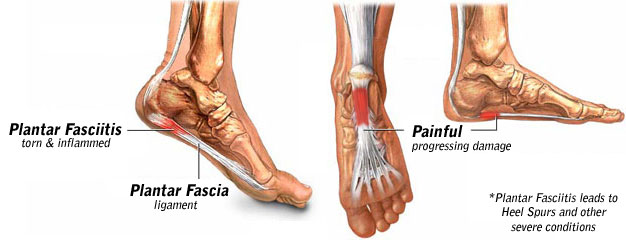What Triggers Plantar Fasciitis

Overview
Plantar fasciitis is that pain in the bottom of your foot usually felt around your heel. That pain is especially strong with the first few steps in the morning as you are getting out of bed and standing on your feet, or after sitting and resting for awhile. The name Plantar fasciitis comes from: "Plantar" which means something that belongs to the foot, "fascia" which is a band or ligament or a connective tissue, and "itis" which means inflammation. The band connects the heel bone to the bones of the toes. The pain is caused by injuring this tough band on the bottom of the foot.
Causes
The cause of plantar fasciitis is poorly understood and is thought to likely have several contributing factors. The plantar fascia is a thick fibrous band of connective tissue that originates from the medial tubercle and anterior aspect of the heel bone. From there, the fascia extends along the sole of the foot before inserting at the base of the toes, and supports the arch of the foot. Originally, plantar fasciitis was believed to be an inflammatory condition of the plantar fascia. However, within the last decade, studies have observed microscopic anatomical changes indicating that plantar fasciitis is actually due to a non-inflammatory structural breakdown of the plantar fascia rather than an inflammatory process. Due to this shift in thought about the underlying mechanisms in plantar fasciitis, many in the academic community have stated the condition should be renamed plantar fasciosis. The structural breakdown of the plantar fascia is believed to be the result of repetitive microtrauma (small tears). Microscopic examination of the plantar fascia often shows myxomatous degeneration, connective tissue calcium deposits, and disorganized collagen fibers. Disruptions in the plantar fascia’s normal mechanical movement during standing and walking (known as the Windlass mechanism) are thought to contribute to the development of plantar fasciitis by placing excess strain on the calcaneal tuberosity.
Symptoms
Plantar fasciitis is characterized by the following signs and symptoms. Acute plantar fasciitis, pain is usually worse in the morning but may improve when activity continues; if the plantar fasciitis is severe, activity will exacerbate the pain, pain will worsen during the day and may radiate to calf or forefoot, pain may be described anywhere from "minor pulling" sensation, to "burning", or to "knife-like", the plantar fascia may be taut or thickened, passive stretching of the plantar fascia or the patient standing on their toes may exacerbate symptoms, acute tenderness deep in the heel-pad along the insertion of the plantar aponeurosis at the medial calcaneal tuberosity and along the length of the plantar fascia, may have localized swelling. Chronic plantar fasciitis, plantar fasciitis is classified as "chronic" if it has not resolved after six months, pain occurs more distally along the aponeurosis and spreads into the Achilles tendon.
Diagnosis
Physical examination is the best way to determine if you have plantar fasciitis. Your doctor examines the affected area to determine if plantar fasciitis is the cause of your pain. The doctor may also examine you while you are sitting, standing, and walking. It is important to discuss your daily routine with your doctor. An occupation in which you stand for long periods of time may cause plantar fasciitis. An X-ray may reveal a heel spur. The actual heel spur is not painful. The presence of a heel spur suggests that the plantar fascia has been pulled and stretched excessively for a long period of time, sometimes months or years. If you have plantar fasciitis, you may or may not have a heel spur. Even if your plantar fasciitis becomes less bothersome, the heel spur will remain.
Non Surgical Treatment
Give your painful heel lots of rest. You may need to stay completely off your foot for several days when the pain is severe. Your healthcare provider may recommend or prescribe anti-inflammatory medicines, such as aspirin or ibuprofen. These drugs decrease pain and inflammation. Adults aged 65 years and older should not take non-steroidal anti-inflammatory medicine for more than 7 days without their healthcare provider’s approval. Resting your heel on an ice pack for a few minutes several times a day can also help. Try to cushion your foot. You can do this by wearing athletic shoes, even at work, for awhile. Heel cushions can also be used. The cushions should be worn in both shoes. They are most helpful if you are overweight or an older adult. Your provider may recommend special arch supports or inserts for your shoes called orthotics, either custom-made or off the shelf. These supports can be particularly helpful if you have flat feet or high arches. Your provider may recommend an injection of a cortisone-like medicine. Lose weight if needed. A night splint may be recommended. This will keep the plantar fascia stretched while you are sleeping. Physical therapy for additional treatments may be recommended. Surgery is rarely needed.

Surgical Treatment
Surgery may be considered in very difficult cases. Surgery is usually only advised if your pain has not eased after 12 months despite other treatments. The operation involves separating your plantar fascia from where it connects to the bone; this is called a plantar fascia release. It may also involve removal of a spur on the calcaneum if one is present. Surgery is not always successful. It can cause complications in some people so it should be considered as a last resort. Complications may include infection, increased pain, injury to nearby nerves, or rupture of the plantar fascia.